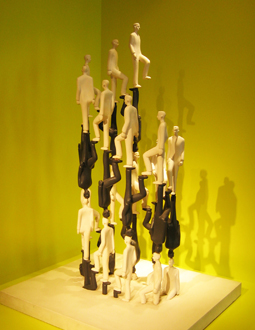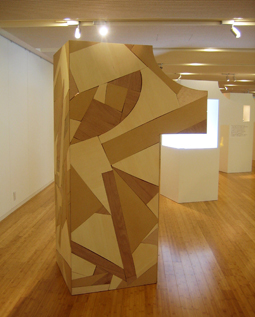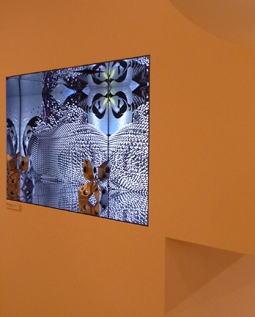 |
|
 |
| "Time" by Shigeo Fukuda |
|
"Weaving Up Together" by Rikyu Nakajima challenges the notion of traditional schools. |
|
|
|
1 - Design for the Next is an intriguing title for an exhibition of works by thirty contemporary Japanese creators working in various genres at the Tokyo Midtown Design Hub. Concurrently, the first group of students from the Faculty of Design at Kyushu University (who graduated last March) is holding a First Anniversary show at the school's Tokyo promotional hub next door. In keeping with the "one" theme, their show is entitled 1st Challenge: Kyushu University Faculty of Design "Critical Juncture."
For the visitor, it is not immediately clear if the 1 - Design for the Next pieces were created around the theme of "one" or rather if each artist simply placed a piece they had selected onto the 1-shaped pedestal that they were given. It turns out that the latter is true, a missed opportunity. The 1-pedestal is a clever vehicle, however, for unifying a broad range of works including sculpture, digital media and communication arts.
Artist Shigeo Fukuda is showing "Time," a black and white sculpture of figures simultaneously ascending and descending upon each other in a spiral formation. This crowd-pleasing piece was originally commissioned for the City of Kawasaki in 1988. "Time" was created simply by stacking figures with either the left or right foot elevated so the piece could theoretically continue to infinity, illustrating Fukuda's concept that the foundation of human history is built on the humans of the past.
Just three "1's" away is the latest work by Professor Yoichiro Kawaguchi of the University of Tokyo Graduate School. "Interactive Multi-Dimensional Butterflies" is a digital growth model displayed on an inset LCD screen enveloped by mirrors on four sides. The mesmerizing computer graphic is based on real-time simulation that constantly expands upon itself. Kawaguchi's work references algorithmic (fractal) art and the artificial intelligence movement. Within the niche created for the screen are two actual three-dimensional models that appear to have emerged from the digital chaos.
After navigating through the "1's" for a while it pays to visit the Kyushu University Faculty of Design's Tokyo site. Many of the pieces there, which range from furniture and sculpture to digital media to environmental and industrial design, show promise. They do not appear to share a common theme, however, and the means of display (haphazardly placed around the room) is underwhelming.
The Critical Juncture piece "Weaving Up Together," by Environmental Planning Department alum Rikyu Nakajima, identifies a school as the core of its community. Nakajima models the concept of locating schools in the space beneath or above major circulation paths. The model on display is elegant, well crafted, and deserves careful consideration.
The "1" that leaves a lasting impression is that by the Trico Design Love! Design Consultancy. Clad in various types of scrap wood left over from the exhibition setup, it stands out as a warm anomaly among the other mostly white 1's. This piece also displays an inventory of all the materials needed to create 1 - Design for the Next. It is a subtle reminder of the inevitable waste that results from even creative endeavors.
 |
|
 |
| An eco-conscious "1" created out of scraps by Trico Design Love! |
|
"Interactive Multi-Dimensional Butterflies" by Yoichiro Kawaguchi
All photos by Nicolai Kruger |
|